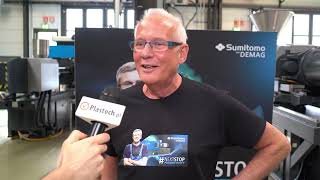The unique cost/performance profile of the new flame-retarded LFT-PP grades makes them suitable for large industrial parts in a number of industries and we see enormous commercial potential for these types of thermoplastics. In addition, we are pleased to be a part of this development team, which fits very well with our corporate growth strategy.”
Formulation work on the new FR LFT-PP compounds took close to two years to complete, but hopefully will shortly pay dividends for all the companies involved. In-house testing by voestalpine showed the FR-LFT grades - in natural, automotive black, and the three new colors of grey, green, and blue - in many cases actually have higher mechanical properties than those of the non-FR base resin, which is an unusual situation.
All compounds featured 30% glass reinforcement, were produced on commercial-scale automotive-industry D-LFT equipment, and were molded on commercial-scale compression presses, and test specimens were subsequently cut from the larger molded plaques.
Voestalpine used a D-LFT charge pattern that yields a very isotropic distribution of glass in the test plaques. While this yields values that are more conservative than otherwise would be expected in the direction of flow, they are also more representative of the results that would be expected from real industrial parts rather than idealized test specimens.
FR testing to European EVN 1187-2002 standards for roofing-membrane materials was conducted by an independent test laboratory (BDA Dakadvies B.V., Gorinchem, The Netherlands) and mechanical testing was performed by voestalpine Plastics Solutions in the company’s internal testing lab using their standard automotive-black LFT-PP grade as the baseline/control.
The new materials are already commercially available from RESIN (Products & Technology) B.V. under the trade name ECO-FORTE compound. They will be custom formulated and supplied ready to use in a granular/pelletized form factor for direct compounding or dilution in a D-LFT process. All formulations contain a high-quality UV stabilization package for protection against the effects of outdoor weathering.
Summing up the work of the last two years, TULiPPS’ Paul Stassen adds, “This project has been an exciting example of what can happen when leading companies join forces to share their knowledge, pool their resources, and work as an integrated supply chain to develop new technology. Without cooperation among all members of the team, we would not have been able to develop these exciting formulations that are now proven recipes.
It’s funny to think about the automotive-composites industry applying its materials and processing expertise to develop the next generation of solar PV modules, but that’s exactly what happened here. Our work represents some real contributions to the state-of-the-art and it will shortly help new industries that haven’t yet experienced the benefit of using LFT composites.”


